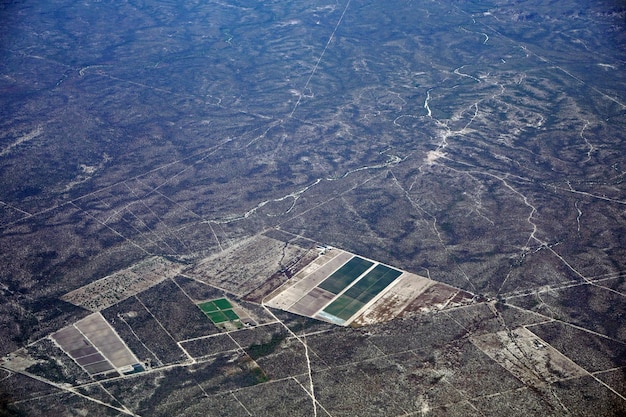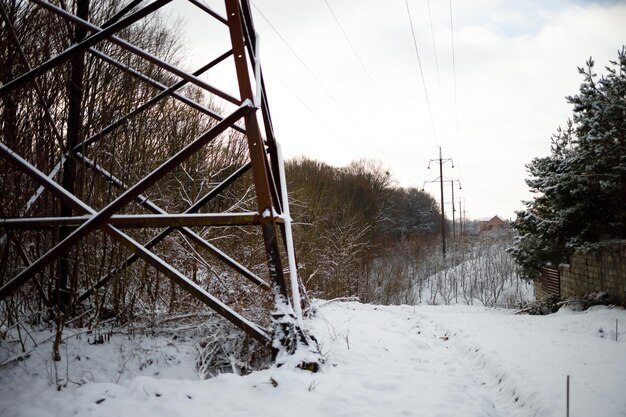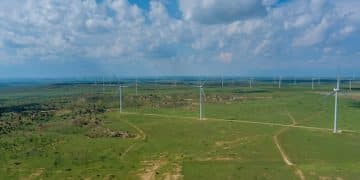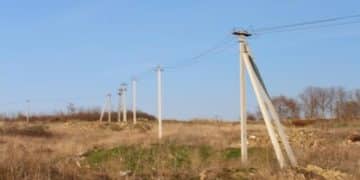Climate Change Impacts on US Energy Infrastructure: Mitigation Strategies

Climate change poses significant threats to the US energy infrastructure, leading to disruptions, increased costs, and reduced reliability; however, these impacts can be mitigated through strategic adaptation measures, technological advancements, and policy interventions.
The US energy infrastructure faces unprecedented challenges from the escalating effects of climate change. Understanding what are the potential impacts of climate change on the US energy infrastructure and how can they be mitigated? is crucial for ensuring a reliable and resilient energy future.
Understanding the vulnerability of US energy infrastructure
The US energy infrastructure, encompassing everything from power generation plants to transmission lines and pipelines, is highly vulnerable to the impacts of climate change. As temperatures rise, sea levels increase, and extreme weather events become more frequent and intense, the reliability and resilience of this critical infrastructure are increasingly at risk.
Key components at risk
Several key components of the US energy infrastructure are particularly susceptible to climate change. Coastal power plants are threatened by rising sea levels and storm surges, while inland facilities face increased risks from heatwaves, droughts, and wildfires. Transmission lines are vulnerable to high winds, ice storms, and extreme temperatures, leading to power outages and disruptions.
- Coastal facilities: Power plants located along the coast are at risk of inundation and damage from rising sea levels and storm surges.
- Inland infrastructure: Power plants and transmission lines in inland areas are vulnerable to heatwaves, droughts, and wildfires.
- Extreme weather events: All components of the energy infrastructure are susceptible to damage from hurricanes, floods, and other extreme weather events.

The impacts of climate change on the US energy infrastructure are already being felt across the country. Recent extreme weather events, such as hurricanes, heatwaves, and ice storms, have caused widespread power outages and disruptions, highlighting the urgent need for adaptation and mitigation measures.
The far-reaching impacts of climate change on energy systems
Climate change has a multitude of potential impacts on the US energy infrastructure. These impacts range from direct physical damage to disruptions in supply chains and changes in energy demand. Addressing these challenges requires a comprehensive understanding of the various pathways through which climate change can affect the energy sector.
Extreme weather’s impact
Extreme weather events, such as hurricanes, floods, and heatwaves, can cause significant damage to energy infrastructure, leading to power outages, fuel shortages, and disruptions to energy services. For example, Hurricane Sandy in 2012 caused widespread damage to power plants, transmission lines, and fuel storage facilities in the Northeast, resulting in billions of dollars in damages and prolonged blackouts.
Rising temperatures
Rising temperatures can reduce the efficiency of power plants and increase energy demand for cooling, putting a strain on the energy grid. Heatwaves can also lead to equipment failures and blackouts, particularly in areas with aging infrastructure. In addition, warmer temperatures can affect the availability of water resources needed for power plant cooling, potentially leading to operational challenges.
- Decreased power plant efficiency: Higher temperatures reduce the efficiency of thermal power plants, requiring them to consume more fuel to generate the same amount of electricity.
- Increased energy demand for cooling: Rising temperatures drive up demand for air conditioning, increasing the load on the energy grid and potentially leading to blackouts.
- Water resource constraints: Warmer temperatures can reduce the availability of water needed for power plant cooling, affecting plant operations.
Climate change can also disrupt energy supply chains, affecting the availability of fossil fuels, renewable energy resources, and other energy inputs. For example, droughts can impact hydropower generation, while extreme weather events can disrupt the transportation of oil and natural gas. These disruptions can lead to price spikes, supply shortages, and increased energy insecurity.
Adaptation strategies for a resilient energy infrastructure
Adapting the US energy infrastructure to the impacts of climate change requires a range of strategies, including hardening infrastructure, diversifying energy sources, and improving grid resilience. These measures can help to reduce the vulnerability of the energy sector to extreme weather events, rising temperatures, and other climate-related stressors.

Hardening infrastructure
Hardening infrastructure involves strengthening existing facilities and building new infrastructure to withstand the impacts of climate change. This can include elevating substations in flood-prone areas, reinforcing transmission towers to withstand high winds, and upgrading power plants to operate more efficiently in warmer temperatures.
Diversifying energy sources
Diversifying energy sources can help to reduce the reliance on any single fuel source and improve the resilience of the energy system to climate-related disruptions. This can include increasing the use of renewable energy sources, such as solar, wind, and geothermal, as well as investing in energy storage technologies to help balance supply and demand.
- Renewable energy: Expanding the use of solar, wind, and geothermal energy can reduce reliance on fossil fuels and improve energy security.
- Energy storage: Investing in energy storage technologies can help to balance supply and demand and enhance grid resilience.
- Microgrids: Developing microgrids can provide backup power to critical facilities during grid outages.
Improving grid resilience involves upgrading the transmission and distribution system to better withstand extreme weather events and other disruptions. This can include installing smart grid technologies to improve grid monitoring and control, as well as investing in backup power systems and microgrids to provide electricity to critical facilities during outages.
Mitigating climate change through energy sector transformation
While adaptation is essential to protect the US energy infrastructure from the impacts of climate change, mitigation is crucial to reduce greenhouse gas emissions and slow the pace of climate change. Transforming the energy sector to rely more on renewable energy sources and improve energy efficiency is a key strategy for mitigating climate change.
Renewable energy transition
Transitioning to a cleaner energy system requires a significant increase in the use of renewable energy sources, such as solar, wind, and geothermal. This can be achieved through policies that promote renewable energy development, such as tax credits, renewable portfolio standards, and feed-in tariffs. In addition, investing in research and development can help to drive down the cost of renewable energy technologies and make them more competitive with fossil fuels.
Energy efficiency improvements
Improving energy efficiency can reduce energy demand and lower greenhouse gas emissions. This can be achieved through policies that promote energy-efficient buildings, appliances, and transportation, such as building codes, appliance standards, and fuel economy standards. In addition, providing incentives for energy efficiency upgrades can help to accelerate the adoption of energy-saving technologies.
- Building codes: Implementing stricter building codes can reduce energy consumption in new buildings.
- Appliance standards: Setting minimum energy efficiency standards for appliances can reduce energy use in homes and businesses.
- Fuel economy standards: Increasing fuel economy standards for vehicles can reduce greenhouse gas emissions from the transportation sector.
Transforming the energy sector also requires investing in new technologies, such as carbon capture and storage, advanced nuclear power, and hydrogen production. These technologies can help to reduce greenhouse gas emissions from fossil fuels and other industrial processes. In addition, developing a smart grid can help to integrate renewable energy sources and improve the efficiency of the energy system.
Policy and investment strategies for a climate-resilient energy future
Creating a climate-resilient energy future requires a combination of policy and investment strategies that promote adaptation, mitigation, and innovation. Governments, businesses, and individuals all have a role to play in ensuring that the US energy infrastructure is prepared for the challenges of climate change.
Policy frameworks
Governments can implement policies that incentivize adaptation and mitigation measures, such as tax credits for renewable energy, building codes that promote energy efficiency, and regulations that require utilities to harden their infrastructure against extreme weather events. In addition, governments can invest in research and development to advance new energy technologies and support the deployment of renewable energy projects.
Investment opportunities
Businesses can invest in climate-resilient infrastructure, such as smart grids, energy storage systems, and distributed generation projects. In addition, businesses can develop and deploy new energy technologies, such as carbon capture and storage, advanced nuclear power, and hydrogen production. These investments can create jobs, stimulate economic growth, and help to reduce greenhouse gas emissions.
- Smart grids: Investing in smart grid technologies can improve grid monitoring and control and enhance resilience to extreme weather events.
- Energy storage: Developing energy storage systems can help to balance supply and demand and improve the reliability of the energy system.
- Distributed generation: Investing in distributed generation projects, such as solar panels and microgrids, can provide backup power to critical facilities during grid outages.
Individuals can also take steps to reduce their energy consumption and support the transition to a cleaner energy system. This can include investing in energy-efficient appliances, installing solar panels on their homes, and using public transportation or electric vehicles. By making these choices, individuals can help to reduce greenhouse gas emissions and create a more sustainable energy future.
Case studies: successful climate resilience initiatives in the US energy sector
Several successful climate resilience initiatives have been implemented in the US energy sector, demonstrating the feasibility and effectiveness of adaptation and mitigation measures. These case studies provide valuable insights into how to build a more climate-resilient energy system.
New York’s REV initiative
New York’s Reforming the Energy Vision (REV) initiative is a comprehensive strategy to transform the state’s energy system to be more resilient, cleaner, and affordable. The REV initiative includes measures to promote renewable energy development, improve energy efficiency, and modernize the grid. As part of the REV initiative, utilities are required to develop climate adaptation plans to protect their infrastructure from extreme weather events.
California’s energy storage mandate
California has implemented an energy storage mandate that requires utilities to procure a certain amount of energy storage capacity by 2020. This mandate has spurred significant investment in energy storage technologies, which can help to balance supply and demand and improve the reliability of the grid. In addition, California has implemented policies to promote the development of microgrids, which can provide backup power to critical facilities during grid outages.
- Energy storage deployment: California’s energy storage mandate has led to significant deployment of energy storage technologies, enhancing grid resilience.
- Microgrid development: Policies promoting microgrid development provide backup power to critical facilities during outages.
- Grid modernization efforts: Investments in grid modernization improve the ability of the grid to withstand extreme weather events.
These case studies demonstrate that with the right policies and investments, the US energy sector can adapt to the impacts of climate change and transition to a cleaner energy system. By learning from these successes and continuing to innovate, the United States can build a climate-resilient energy future that benefits all Americans.
| Key Point | Brief Description |
|---|---|
| ⚠️ Climate Threats | Extreme weather poses risks like floods, heatwaves, and outages. |
| 🌱 Renewable Transition | Switching to renewables reduces emissions & enhances grid resilience. |
| 🛡️ Infrastructure Hardening | Strengthening infrastructure mitigates climate impacts. |
| 💡 Policy & Investment | Strategic policies and investments are vital for a resilient energy future. |
FAQ
▼
Immediate threats include increased frequency and intensity of extreme weather events like hurricanes, floods, and heatwaves, which can directly damage energy infrastructure and disrupt operations.
▼
Renewable energy sources, especially when coupled with energy storage, diversify the energy supply, reducing reliance on single points of failure and enhancing the grid’s ability to withstand disruptions.
▼
Microgrids provide localized power during grid outages, enhancing resilience by allowing critical facilities like hospitals and emergency services to continue operating independently from the main grid.
▼
Effective policy changes include tax incentives for renewable energy, mandates for energy storage, and regulations requiring utilities to harden infrastructure against extreme weather events.
▼
Individuals can contribute by investing in energy-efficient appliances, installing solar panels, using public transportation or electric vehicles, and supporting policies that promote renewable energy and energy efficiency.
Conclusion
Addressing the impacts of climate change on the US energy infrastructure requires a multifaceted approach that combines adaptation, mitigation, policy changes, and investment in new technologies. By taking proactive steps to protect and transform the energy sector, the United States can build a more resilient, sustainable, and secure energy future.





